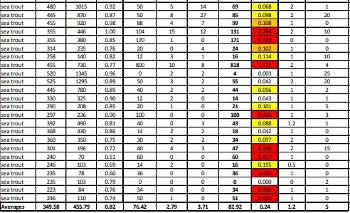Are lice levels too high to safeguard wild salmon migrating through coastal waters around Wester Ross?
Posted: Wednesday 2 June, 2021 @ 11:09:57

The Wester Ross Fisheries Trust sweep netting team sampled sea trout in the Flowerdale estuary, Loch Gairloch on 30th April. The aim was to obtain a sample of last year’s finnock and sea trout and to record length, weight and counts of parasitic sea lice for each fish. From sampling in previous years at this site, we know that many of the older sea trout return to the sea ahead of the smolts.
Because they have been living in coastal waters for several weeks prior to the annual emigration of smolts, these older fish can provide a useful indication of sea lice infection pressures at the time when the sea trout and salmon smolts enter the sea for their first time.
Over 50 trout were caught. The majority were small (<200mm) post-smolt sea trout, likely to have just entered the estuary from the nearby burn. These smaller fish were carefully returned without being processed. We plan to sample them again in early June after they have spent longer in the sea and been exposed to sea lice infection pressure.
Twenty four larger trout were also caught of lengths 223mm to 525mm. All but one of these fish carried sea lice.
Summary data can be found here or by clicking on link below:
http://www.wrft.org.uk/files/flowerdale%2030%20apr%2021%20sea%20trout%20sea%20lice%20data.pdf
Colour coded ‘traffic light’ scores for ‘risk’ to individual trout follow definitions in Tarranger et al 2015.
The most heavily liced fish was a sea trout of 455mm which carried an estimated 800 lice, the majority of which were small early stage lice indicative of very high concentrations of copepodid lice in nearby waters. This is one of the most heavily liced fish recorded by WRFT over 20 years of sampling.
Dorsal fin damage scores were indicative of higher numbers of lice on some of the trout than observed; the sampling site is in the estuary of the Flowerdale burn where trout are able to move into freshwater where, after a period of several days, sea lice detach from their hosts.
The longest fish (525mm, 1295g) was subsequently recognised as a fish that had previously been captured at the same site in September 2019 [click here to see]. Sea trout have been sampled at the Flowerdale site over many years, and several fish have been recaptured in previous years at this location including some fish in April, June and September.
By living close to freshwater, some sea trout are able to rid themselves of potentially lethal infestation by parasitic lice. Perhaps these fish should be regarded as ‘sea loch trout’ or ‘fjord trout’ rather than ‘sea’ trout as their survival appears to be indicative of an ability to move in and out of sea water from the fresh or brackish water which tends to form a layer on the surface especially near river estuaries. These fish are able to advantage of marine feeding opportunities without succumbing to sea lice infestation.
Since 2015, lice levels observed on sea trout at this site in the spring have been higher during odd years than during even years. Lice levels on sea trout sampled in the spring at Flowerdale have been higher during the second year of the production cycle at salmon farms in Loch Torridon nearby. The nearest salmon farm to the Flowerdale sweep netting site is the Sgeir Dughall salmon farm operated by the Scottish Salmon Company. Further discussion can be found in the SWRFT Review 2020.
In late winter and early spring 2021, salmon farms in the east of Skye including the new Mowi Scalpay salmon farm and Organic Sea Harvest Invertote salmon farm also reported high numbers of lice (above the SSPO Code of Good Practice levels). When multiplied by estimates of projected on-farm salmon numbers, total adult female sea lice populations are very high. SSPO sea lice figures for March 2021 can be found here. Based on sea lice dispersal models, these new salmon farms provide additional sources of sea lice which can infect both sea trout and salmon smolts migrating through the coastal waters of Wester Ross.
In contrast to sea trout, wild salmon smolts which become infested with potentially lethal numbers of sea lice do not return to freshwater; they swim on until damage associated with sea lice infestation causes premature mortality, most likely due to becoming more easily caught by fish eating predators.
Thank you very much to local volunteers for helping with sea trout sampling.
Funding has not yet been secured from the Scottish Government or from salmon farm industry sources to provide for adequate monitoring of sea lice on wild sea trout this year around Wester Ross to assess the risk of damage to wild fish populations, despite high reported sea lice levels on many nearby salmon farms. Further sea trout sampling is planned for June and early July with support from WRASFB and volunteers. If you are able to support this work as a volunteer or by making a donation, please contact Peter C at info@wrft.org.uk or Peter J admin@wrft.org.uk.